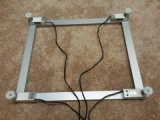Difference between revisions of "Frame Designs"
(→Designs) |
(→Designs) |
||
| Line 33: | Line 33: | ||
File:20150224 214129.jpg | File:20150224 214129.jpg | ||
File:VacuumFormFinish1.JPG | File:VacuumFormFinish1.JPG | ||
| + | File:UB15.JPG | ||
</gallery> | </gallery> | ||
Revision as of 03:47, 17 March 2017
Goals
Two different designs:
- A low cost load cell mounting system for 1, 2 or 4 load cells for a mass produced and sold as a consumer product.
- A load cell mounting system that can be built from readily available materials by students using tools found in a home shop.
- light weight
- durable (won't rust, rot, or become brittle)
- overload limit
- protect load cells from uneven heating
- enclose electronics and conceal or protect wires.
Many interesting and innovative designs have been suggested, built and tested.
Designs
Several frames have been designed, each with advantages and disadvantages:
- Punched and bent
- Welded Steel Rectangular Tubing
- Progressive die stamped and welded
- Unistrut/SuperStrut
- 3D printed corner brackets/metal tubing
- Frameless (2 rails) using strut
- Octanorm aluminum extrusion with torx cam locks
- Vacuum Forming: A Plastic/Aluminum Hybrid Frame
- Ultimate Bottom Board: Utilizing a Manufactured Frame with Aluminum Undercarrage
- Thrifty-Bee Scale: A Low-Cost All Aluminum Scale
- Error creating thumbnail: File missing
- Error creating thumbnail: File missing
- Error creating thumbnail: File missing

